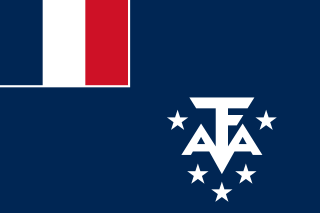
The Crozet Islands are a sub-Antarctic archipelago of small islands in the southern Indian Ocean. They form one of the five administrative districts of the French Southern and Antarctic Lands.
The Wisconsin Range is a major mountain range of the Horlick Mountains in Antarctica, comprising the Wisconsin Plateau and numerous glaciers, ridges and peaks bounded by the Reedy Glacier, Shimizu Ice Stream, Horlick Ice Stream and the interior ice plateau.
The Argentina Range is a mountain range of rock peaks and bluffs, 68 km (42 mi) long, lying 56 km (35 mi) east of the northern part of Forrestal Range in the northeastern portion of the Pensacola Mountains of Antarctica. Discovered and photographed on January 13, 1956, in the course of a US Navy transcontinental nonstop plane flight from McMurdo Sound to Weddell Sea and return.
The Darwin Mountains is a group of mountains between the Darwin and Hatherton glaciers in Antarctica. Discovered by the British National Antarctic Expedition (1901–04) and named for Major Leonard Darwin, at that time Honorary Secretary of the Royal Geographical Society.
Lützow-Holm Bay is a large bay, about 220 kilometres (120 nmi) wide, indenting the coast of Queen Maud Land in Antarctica between Riiser-Larsen Peninsula and the coastal angle immediately east of the Flatvaer Islands. It was discovered by Captain Hjalmar Riiser-Larsen in two airplane flights from his expedition vessel, the Norvegia, on February 21 and 23, 1931. The name honours Commander Finn Lützow-Holm of the Royal Norwegian Navy Air Service, a pilot for Captain Riiser-Larsen on the Aagaard in 1935.
Michael Edward Hazlewood was a British singer, composer and songwriter. He variously worked with Albert Hammond, T-Bone Burnett, Van Dyke Parks and Harry Nilsson.

Faure Island is a 58 km2 island pastoral lease and nature reserve, east of the Francois Peron National Park on the Peron Peninsula, in Shark Bay, Western Australia. It lies in line with the Monkey Mia resort to the west, and the Wooramel River on the eastern shore of Shark Bay. It is surrounded by the Shark Bay Marine Park and Shark Bay World Heritage Site and, as the Faure Island Sanctuary, is owned and managed by the Australian Wildlife Conservancy (AWC).

Belkin is an American consumer electronics and networking company headquartered in Playa Vista, California. It produces mobile and computer connectivity devices and peripherals for consumer and commercial use. These include wireless chargers, power banks, charging cables, data cables, audio and video adapters, headphones, earbuds, smart speakers, screen protectors, surge protectors, Wi-Fi routers, smart home products, electronic device sanitizers, docking stations and data hubs, network switches, KVM switches and network cables.
The Duroch Islands are a group of islands and rocks which extend over an area of about 5 km2 (1.9 sq mi), centred about 1 km (0.62 mi) off Cape Legoupil on the north coast of Trinity Peninsula, Antarctica. They were discovered by a French expedition under Captain Jules Dumont d'Urville, 1837–40, who gave the name "Rocher Duroch" to one of the larger islands in the group after Ensign Joseph Duroch of d'Urville's expedition ship, the Astrolabe. The Falkland Islands Dependencies Survey, which charted the islands in 1946, recommended that the name Duroch be extended to include the entire group of islands. The islands are close to Chile's Bernardo O'Higgins Station at Cape Legoupil.
Fuller Rock is a rock awash, one of the principal dangers to ships on the north side of Faure Passage, Marguerite Bay, Antarctica, about 7.8 kilometres (4.2 nmi) south-southwest of Dismal Island. It was charted by a Royal Navy Hydrographic Survey Unit from RRS John Biscoe in January 1973 and named after Lieutenant Andrew C. Fuller, Royal Navy, who directed the survey.
Dismal Island is an island, 1.9 kilometres (1 nmi) long and 60 metres (200 ft) high, which is mainly ice covered and is the largest of the Faure Islands, lying in Marguerite Bay off the west coast of Graham Land. The Faure Islands were discovered and first charted in 1909 by the French Antarctic Expedition under Jean-Baptiste Charcot. The group was visited and surveyed in 1949 by the Falkland Islands Dependencies Survey, who so named this island for its appearance of extreme desolation and lifelessness.
Fauré Inlet is an ice-filled inlet on the south side of the Monteverdi Peninsula and is also the only inlet on the Monteverdi Peninsula in the south portion of Alexander Island, Antarctica. It was discovered and first charted by Finn Ronne and Carl Eklund of the United States Antarctic Service, 1939–1941. It was named by the UK Antarctic Place-Names Committee, 1977, in association with the names of composers grouped in this area, after Gabriel Fauré, the French composer 1845–1924.
Faure Passage is a marine channel or passage between the Faure Islands and Kirkwood Islands in Marguerite Bay. The name "Pasaje Faure" was applied by Argentine workers in the area in association with the Faure Islands.
Haydn Inlet is an ice-filled inlet indenting the west coast of Alexander Island, Antarctica, lying between Mozart Ice Piedmont and Handel Ice Piedmont. Schubert Inlet lies to the south and the Lassus Mountains are immediately north. Haydn Inlet is 27 nautical miles (50 km) long and 12 nautical miles (22 km) wide at the mouth, narrowing toward the head. It was first seen from the air and roughly mapped by the United States Antarctic Service, 1939–41. It was resighted from the air and photographed by the Ronne Antarctic Research Expedition, 1947–48, and remapped from these photos by D. Searle of the Falkland Islands Dependencies Survey in 1960. The inlet was named by the UK Antarctic Place-Names Committee for Joseph Haydn, the Austrian composer.
The Kirkwood Islands are a scattered group of reefs and rocks, with one larger island, lying in the central part of Marguerite Bay, 28 kilometres (15 nmi) south-southwest of the Faure Islands, Antarctica. The islands were sighted in 1949 from the Falkland Islands Dependencies Survey vessel John Biscoe, and a running survey was made from the ship in 1950. They are named for Commander Henry Kirkwood, Royal Navy, in command of the John Biscoe at that time.
Verdi Inlet is an ice-filled inlet lying between Pesce Peninsula and Harris Peninsula, on the north side of the Beethoven Peninsula, situated in the southwest portion of Alexander Island, Antarctica. The inlet was observed from the air and first roughly mapped by the Ronne Antarctic Research Expedition in 1947–48. Remapped from the RARE air photos by Searle of the Falkland Islands Dependencies Survey in 1960. Named by United Kingdom Antarctic Place-Names Committee after Giuseppe Verdi (1813–1901), Italian opera composer.
Lurker Rock is a rock 3 metres (10 ft) high, located 6 kilometres (3 nmi) northeast of Dismal Island, Faure Islands, in Marguerite Bay, Antarctica. It was charted by the Hydrographic Survey Unit from RRS John Biscoe in 1966. The name, applied by the UK Antarctic Place-Names Committee in 1971, is descriptive of the feature, which is covered by ice and can easily be mistaken for a piece of floating ice, especially at high water.
A pipkin is an earthenware cooking pot.

Antonio Pipkin is a Canadian football quarterback for the Toronto Argonauts of the Canadian Football League (CFL). He played college football at Tiffin. Pipkin has also been a member of the Arizona Cardinals (NFL), the Montreal Alouettes, and the Edmonton Football Team.
Robert Pipkins is an American former luger. He competed at the 1992 Winter Olympics and the 1994 Winter Olympics. He was the first African-American to represent the United States in the luge at an international level.




